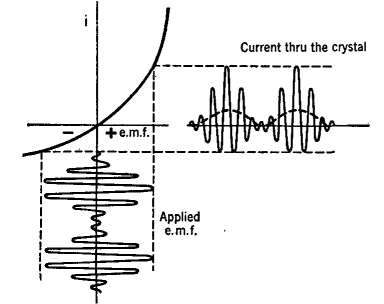| Basic Radio is a free introductory textbook on electronics based on tubes. See the editorial for more information.... |

|

Home  Transmission of Signals Transmission of Signals  The Principle of Detection The Principle of Detection  Introduction Introduction |
|||||
| See also: Diode Detector Circuits, A Comparison of Detectors | |||||






|
|||||
|
The Principle of DetectionAuthor: J.B. Hoag When a modulated carrier wave has been received, it is necessary to use a "detector" to separate, its audio component from its radio frequency component, if one is to hear the message sent into the microphone at the transmitter. In other words, the modulated wave must be demodulated. This may be accomplished by sending the wave through a non-linear device, i.e., through one whose current is not directly (linearly) proportional to the impressed voltage. For example, one may use certain crystals such as galena or iron pyrites which are much better conductors of current in one direction than in the other (roughly 10 to 1 better).
In Fig. 17 A, the electromagnetic waves, cutting the antenna wires, induce an e.m.f. whose amount is strengthened by the tuned circuit. The e.m.f. across the condenser sends a current i through the crystal in greater amount in one direction than in the other, as indicated in Fig. 17 B.
The semi-direct-pulsating current stores energy in condenser C. This, in turn, feeds through the phones in an amount indicated by the dotted line in Fig. 17 B, whose wave form is like the audio-modulation component of the input wave, i.e., like the original audio sound waves at the transmitter.
|
|||||
Home  Transmission of Signals Transmission of Signals  The Principle of Detection The Principle of Detection  Introduction Introduction |
|||||
Last Update: 2009-11-01



